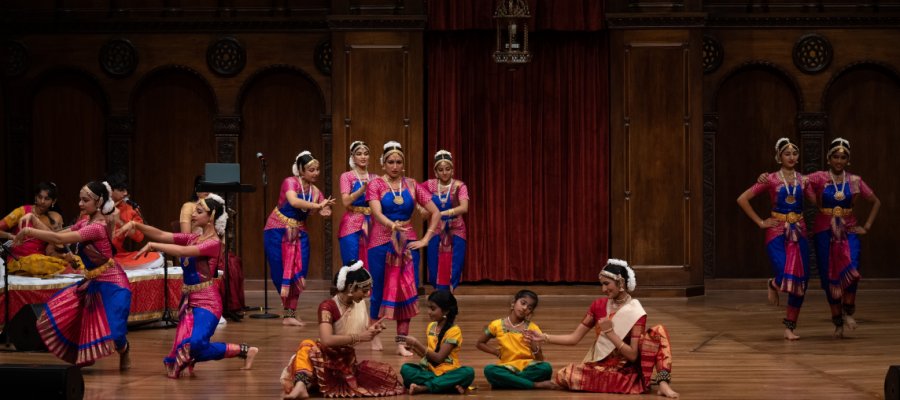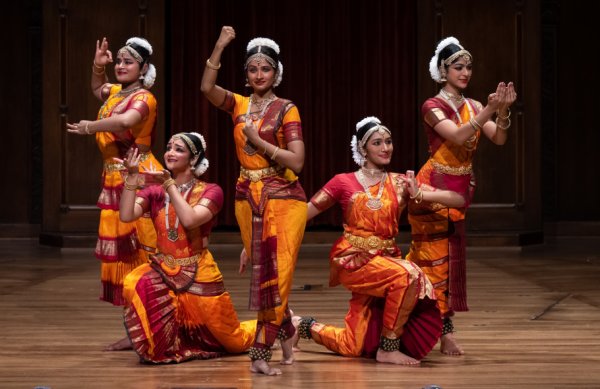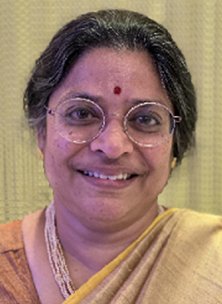
|   |

|   |
Manas: The Charioteer Within - Dr. Ganga Lakshmi Srinivas e-mail: gangalakshmi@gmail.com Photos: Koti Ravi December 7, 2022 To retain the abstract relationship between the mind and the senses while presenting a tangible story, and to lead the audience in a journey within and without while fully engaged in an intense sensory experience takes a high degree of genius - this was on full display at the debut of Guru Sujatha Srinivasan's 'Manas: The Charioteer Within' at the Milton and Tamara Maltz Performing Arts Center's Silver Hall Concert series at the Temple Tifereth-Israel within Case Western Reserve University. Manas draws from Sujatha's lived understanding of the philosophies of the Veda and the Bhagavad Gita, infuses it with stories that buffet us from the front pages of the news, and then throws us back into introspection. This Shri Kalaa Mandir production explored the perpetual struggle for control between the mind and the 5 senses - sight, hearing, smell, taste and touch. Sujatha's choreography fully used the traditions and tropes of Bharatanatyam to convey ancient and modern musings via the exquisite abhinaya and natya that is a hallmark of her Vazhuvoor tradition, highly honed in her sishyas. Beginning with music that was meditative and then moved on to a celebration of the senses, the production opens with verses from the Kathopanishad that establish the metaphor of the Charioteer mind yoked to the 5 senses (horses) who explore pleasures that distract and overwhelm. In the next act, the senses have taken supremacy. This is explored first as individual greed in the story of King Midas, and then moves outward to social constructs that assault the self and mind - of oppression and subjugation of women, and the divisions and borders in society, and man's inhumanity to man in this context. The 3rd act reinstates the mind in charge of the senses, a high goal in the spiritual journey of many traditions. In a tranquil minimalist solo by Sujatha, the mind realizes the Self, and finally connects with the consciousness of the universe.  The auditorium is small and intimate, and the stage is small and jewel like. Sujatha's nattuvangam and Ethirajan Ramanujam's precise mridangam reverberated to fill the auditorium without needing undue amplification. The result was an immersive experience. Lalit Subramanian's effortless voice was the perfect accompaniment - filled with emotion when singing Subramania Bharati's or Perumal Murugan's poetry, and infused with the underlying rhythms of the recitation of the Vedas and the Gita. The delightful flautist and violinist, Raghav Kasibhatla and Laya Raghav respectively, were teenagers who carried their parts flawlessly, able accompanists to the many teenage junior dancers in the troupe. A special mention must be made of the intense and tight choreography of the mother-daughter duo of Guru Sujatha and Dr. Shriya Srinivasan. On a stage designed for lectures and small music concerts, over a dozen dancers built the scene of the iniquity of borders, moving in patterns which evoked the complexity of people moving, settling, enlarging communities. As the mind grasped one pattern of intersecting lines and squares, the eye was confronted with a new one. In that small space, young dancers sometimes moved backwards with scarcely an inch to spare, portraying chaos while in tune with the music and talam, their fellow dancers, their space and the audience with remarkable performative maturity. That dense mass made it even more poignant that children were separated deliberately from parents with little attention from neighbors to the tragedy unfolding.  Ami Majmudar's story-telling narration was a classy touch (rather than an obtrusive emcee), and projection onto an unexpectedly tasteful jumbotron discreetly placed above the stage kept the mixed audience aware of the thread, with the verses from the Vedas and the Gita displayed both in transliteration and translation. Unfortunately, Perumal Murugan's poetry was only projected in translation. Projecting his simple poetry that strikes at the heart of the truth unerringly would have enhanced that segment. What could have been done better? This program of slightly over an hour was sweeping in breadth and depth, as complex in presentation as the verses that formed the music. It was like drinking the ocean. The presentation would have been tighter without the allusion to the societal oppressions, but these are still constructs that can be reined in by a mind in control of itself. The dancing and the choreography in those segments were brilliant, though, and I would not want to miss those. Some minor irritants were the result of being a small company with not enough hands for all tasks - the junior dancers had a false start at the beginning; the jumbotron verses were out of sync with the performance a couple of times. And I wish Perumal Murugan's poetry had been printed in the original Tamil in the program notes as well. I dearly hope that this production is seen at other venues and by other audiences. I would like to view this again to see portions that I missed because my attention was pulled in so many directions. An amazing, fulfilling performance, as rare as the brilliant sunny fall day in Cleveland when it debuted.  Dr. Ganga Lakshmi Srinivas is a practicing pediatrician in Cleveland, Ohio. Her love for the Indian performing arts began in childhood growing up in a family that reveres music, and has continued to be nurtured in the rich landscape of tenacious teachers and performers who keep traditional arts thriving in the United States. |